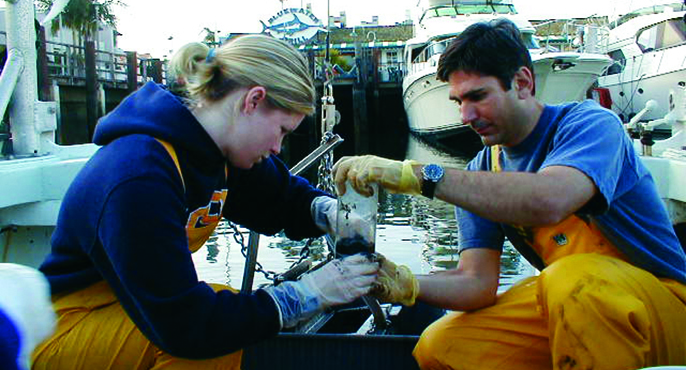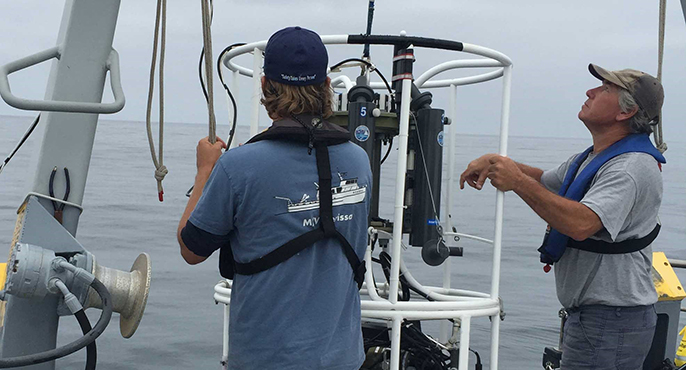For more than 50 years, SCCWRP has applied next-generation science to improve monitoring, assessment and modeling of aquatic systems in Southern California and beyond. Research conducted by SCCWRP has served as the foundation for management decision-making and regulatory policies that have extended important new protections to ecosystems, wildlife and humans.
SCCWRP’s adeptness in bringing next-generation science to the environmental management community is rooted in a foundation of scientific excellence. SCCWRP scientists have published more than 1,000 reports and peer-reviewed articles in more than 50 journals. SCCWRP maintains a robust publication rate on par with its partners at academic research institutions, and its peer-reviewed journal publications are cited about 20% more frequently than the average for the aquatic sciences discipline.
Research portfolio
SCCWRP leverages its direct connections to Southern California’s water-quality management community to set an independent research agenda that guides its priorities and directions. SCCWRP’s research portfolio is organized around eight major thematic research areas:
Bioassessment
![]() As environmental managers increasingly turn to measuring the health of aquatic systems through biological assessments – or bioassessment – SCCWRP is developing next-generation approaches that use benthic invertebrates, algae and other organisms to evaluate ecological condition across a variety of environments, from streams to the coastal ocean.
As environmental managers increasingly turn to measuring the health of aquatic systems through biological assessments – or bioassessment – SCCWRP is developing next-generation approaches that use benthic invertebrates, algae and other organisms to evaluate ecological condition across a variety of environments, from streams to the coastal ocean.
Ecohydrology
![]() As environmental managers work to protect aquatic systems and the biological communities they support from human-induced alterations to hydrological flow patterns, SCCWRP is working to better understand these ecohydrological relationships and how to develop science-informed best management practices around them.
As environmental managers work to protect aquatic systems and the biological communities they support from human-induced alterations to hydrological flow patterns, SCCWRP is working to better understand these ecohydrological relationships and how to develop science-informed best management practices around them.
Eutrophication
With anthropogenic nutrient inputs a leading cause of eutrophication – or accelerated accumulation of organic matter from overgrowth of aquatic plants and algae – SCCWRP is working to help environmental managers understand the deleterious impacts of excessive nutrients and how they can more effectively manage nutrient loading to water bodies.
Climate Change
![]() As environmental managers seek out next-generation solutions for mitigating and offsetting the local impacts of global carbon dioxide emissions, SCCWRP is developing strategies to optimally position vulnerable aquatic systems – and the biological communities they support – to cope with and adapt to climate change.
As environmental managers seek out next-generation solutions for mitigating and offsetting the local impacts of global carbon dioxide emissions, SCCWRP is developing strategies to optimally position vulnerable aquatic systems – and the biological communities they support – to cope with and adapt to climate change.
Emerging Contaminants
![]() To help environmental managers identify which of the tens of thousands of largely unmonitored CECs in aquatic systems pose the greatest potential health risks to wildlife and humans, SCCWRP is developing novel approaches to rapidly and cost-effectively screen water bodies for CECs, connect screening-level monitoring data to higher-level biological responses, and understand exposure routes.
To help environmental managers identify which of the tens of thousands of largely unmonitored CECs in aquatic systems pose the greatest potential health risks to wildlife and humans, SCCWRP is developing novel approaches to rapidly and cost-effectively screen water bodies for CECs, connect screening-level monitoring data to higher-level biological responses, and understand exposure routes.
Microbial Water Quality
![]() With runoff and discharge introducing potentially pathogenic waterborne microbes into coastal waters, especially at populated beaches, SCCWRP is working to more rapidly and effectively detect this microbial contamination, identify the source(s) of the contamination, and understand the risk of illness from water contact.
With runoff and discharge introducing potentially pathogenic waterborne microbes into coastal waters, especially at populated beaches, SCCWRP is working to more rapidly and effectively detect this microbial contamination, identify the source(s) of the contamination, and understand the risk of illness from water contact.
Stormwater BMPs
To help environmental managers more effectively control the quality and quantity of water that runs off the land during both wet and dry weather, SCCWRP is pursuing comprehensive, solutions-focused research to clarify how to design and implement stormwater BMPs (best management practices) that optimally protect downstream water quality and ecosystems.
Regional Monitoring
![]() To give environmental managers comprehensive, big-picture snapshots of the condition of aquatic systems and how they are changing over time, SCCWRP facilitates the design and execution of multi-agency regional monitoring – notably, the Southern California Bight Regional Monitoring Program and the Southern California Stormwater Monitoring Coalition Regional Watershed Monitoring Program.
To give environmental managers comprehensive, big-picture snapshots of the condition of aquatic systems and how they are changing over time, SCCWRP facilitates the design and execution of multi-agency regional monitoring – notably, the Southern California Bight Regional Monitoring Program and the Southern California Stormwater Monitoring Coalition Regional Watershed Monitoring Program.

Strategic, long-range research
SCCWRP research spans multiple years and transcends individual projects. SCCWRP works closely with its 14 member agencies to ensure SCCWRP research remains relevant to and aligned with the needs and priorities of its core audience of water-quality managers. SCCWRP maintains a detailed Research Plan, updated annually, that explains how SCCWRP conceptually approaches each of its eight thematic research areas and how each element of the agency’s multi-faceted research strategy fits together to advance the long-term research needs of the water-quality management community.
Because of the unique role SCCWRP plays at the nexus of science and water-quality management, SCCWRP prioritizes consensus-building in the scientific community to streamline the transfer of next-generation science to decision-makers. SCCWRP plays an international leadership role in promoting knowledge-sharing, research collaborations and scientific consensus. At any given time, SCCWRP scientists are serving in leadership capacities for about 100 professional societies, scientific advisory committees and other scientific organizations.
